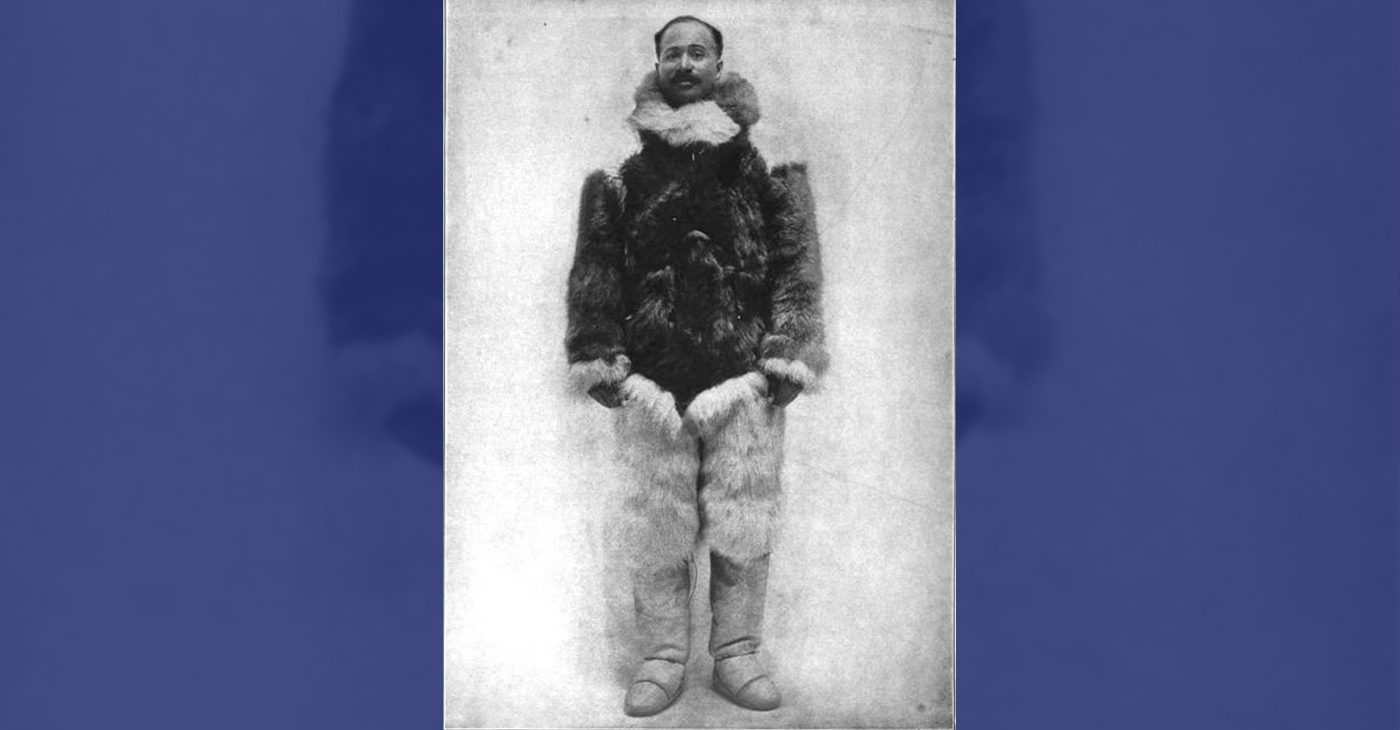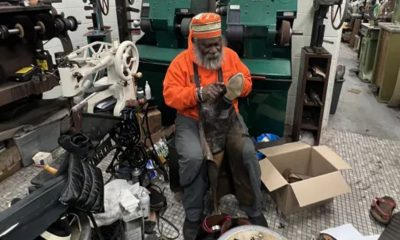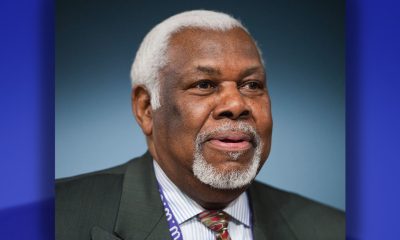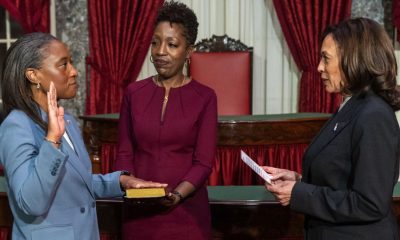Black History
COMMENTARY: California Congresswoman Maxine Waters Makes History
NNPA NEWSWIRE — Congresswoman Maxine Waters is now the first Black and the first woman to chair the powerful House Financial Services Committee. Having served on this committee since 1995, and its Ranking Member in the previous Congress, Waters will set the committee’s agenda in key areas affecting the economy, banking, housing, insurance and securities.
By Charlene Crowell, NNPA Newswire Contributor
As 2019 begins, there is also a new Congress with leadership in the House of Representatives that makes history for people of color and women alike.
Long-time California Representative Nancy Pelosi returns as Speaker of the House – the first time in 50 years that a Member of Congress has achieved this feat. On a gender note, Speaker Pelosi becomes the most powerful woman on Capitol Hill and the only female in the nation’s history to do so.
There’s also another key woman and legislator that is making history. Congresswoman Maxine Waters is now the first Black and the first woman to chair the powerful House Financial Services Committee. Having served on this committee since 1995, and its Ranking Member in the previous Congress, Waters will set the committee’s agenda in key areas affecting the economy, banking, housing, insurance and securities.
The House Financial Services Committee oversees the activities and responsibilities for major financial regulators, agencies, and the nation’s central bank, the Federal Reserve. These agencies include but are not limited to the Department of Housing and Urban Development (HUD), the Federal Deposit Insurance Corporation – that insures monies in depository institutions, as well as the Securities and Exchange Commission that is charged with maintaining fair and efficient investment markets.
In other words, the fiery and bold Black lawmaker who earned a reputation for challenging Wall Street and major lenders during the housing crisis will now set the direction for a range of financial players, regulators, and institutions. From monetary policy to the production and distribution of currency, and expanding financial access to affordable housing options, a progressive and principled committee chair is running the show. She is also expected to set standards of performance that level the financial playing field and hold lenders accountable when they take advantage of consumers or discriminate in their lending.
With the right kind of regulation and committee oversight, the nation may be able to change financial trends that have worsened both racial and gender wealth gaps.
For example, a December 2018 report by the Asset Funder’s Network analyzed racial and gender disparities in wealth and found that Black and Latina women have “lost substantial amounts of wealth in the last two decades”.
From 2007 to 2016, Black women ages 45-65 had a 74 percent drop in median wealth, compared to that of White women who experienced a 28 percent drop. Further, the Asset Funders Network concluded the median “quasi-liquid” savings for single Black and Latina women aged 45-50 was $0.
Earlier in 2017 the Federal Reserve found that nearly 1 in 5 black families have zero or negative net worth — twice the rate of white families. Additionally the median net worth of Black families was one-tenth of that held by White families.
These wealth disparities continue to plague communities of color in large part because of disparities in home ownership that enable consumers to build wealth. Year after year, the Home Mortgage Disclosure Act (HMDA) report has consistently found that consumers of color are denied access to mortgages, especially private conventional loans that remain the most sustainable and affordable loans.
Last year, the Center for Investigative Reporting published its analysis of the most recent HMDA report. “It found a pattern of troubling denials for people of color across the country, including in major metropolitan areas such as Atlanta, Detroit, Philadelphia, St. Louis and San Antonio,” states the report. “African Americans faced the most resistance in Southern cities – Mobile, Alabama; Greenville, North Carolina; and Gainesville, Florida – and Latinos in Iowa City, Iowa.”
A second but equally harmful trend is predatory lending that targets these same consumers with high-cost credit that creates debt traps. When consumers find themselves short of cash before paydays, overdraft fees, payday and car title loans are among the most predatory due to their extremely high interest rates and failure to consider whether borrowers have the financial capacity to repay the loans without taking on additional debt.
For all of Black America, as well as consumer advocates and others who believe financial fairness should be the nation’s watchword, an expectation of a new era of accountability, access and transparency is hoped to soon unfold.
“She is a tough and savvy defender of consumer protection and holds the feet of the banks and the Trump administration regulators to the fire,” said Mike Calhoun, president of the Center for Responsible Lending in a recent interview.
Should anyone doubt the resolve of Congresswoman Waters, consider her reaction last fall when she and other prominent progressives faced a series of bomb threats and other violence.
“We have to keep doing what we’re doing in order to make this country right,” Waters told the Washington Post. “That’s what I intend to do. And as the young people say, ‘I ain’t scared.’”
Charlene Crowell is the Center for Responsible Lending’s Communications Deputy Director. She can be reached at Charlene.crowell@responsiblelending.org.
Activism
Oakland Post: Week of April 17 – 23, 2024
The printed Weekly Edition of the Oakland Post: Week of April 17 – 23, 2024

To enlarge your view of this issue, use the slider, magnifying glass icon or full page icon in the lower right corner of the browser window. ![]()
Black History
Matthew Henson: Explorer Extraordinaire
Matthew Henson, a trailblazing explorer who overcame countless obstacles to leave an incredible mark on history. Born on August 8, 1866, in Charles County, Maryland, his journey is a testament to the power of determination and the spirit of adventure.

By Tamara Shiloh
Matthew Henson, a trailblazing explorer who overcame countless obstacles to leave an incredible mark on history. Born on August 8, 1866, in Charles County, Maryland, his journey is a testament to the power of determination and the spirit of adventure.
Henson’s life began amidst the backdrop of post-Civil War America, where opportunities for African Americans were scarce. From a young age, he possessed an insatiable curiosity about the world beyond his small town. At the age of 12, he embarked on a journey that would change the course of his life forever when he joined a merchant ship as a cabin boy.
His most famous expedition was his journey to the Arctic with renowned explorer Robert E. Peary. In 1887, Henson joined Peary’s crew as a seaman and quickly proved himself to be invaluable with his skills as a navigator and craftsman. Over the course of several expeditions, Matthew endured extreme cold, treacherous terrain, and grueling conditions as he and Peary sought to reach the elusive North Pole.
In 1908–09, Peary set out on his eighth attempt to reach the North Pole. It was a big expedition, with Peary planning to leave supplies along the way. When he and Henson boarded their ship, the Roosevelt, leaving Greenland on August 18, 1909, they were joined by a large group. This included 22 Inuit men, 17 Inuit women, 10 children, 246 dogs, 70 tons of whale meat, blubber from 50 walruses, hunting gear, and tons of coal.
In February, Henson and Peary left their anchored ship at Ellesmere Island’s Cape Sheridan, along with the Inuit men and 130 dogs. They worked together to set up a trail and supplies along the way to the Pole.
Peary picked Henson and four Inuit people to join him in the final push to the Pole. However, before they reached their destination, Peary couldn’t walk anymore and had to ride in a dog sled. He sent Henson ahead to scout the way. In a later interview with a newspaper, Henson recalled being in the lead and realizing they had gone too far. The group turned back, and Henson noticed his footprints helped guide them to their destination. At that location, Henson planted the American flag.
Henson’s legacy extends far beyond his expeditions to the Arctic. He shattered racial barriers in the world of exploration and inspired countless individuals, regardless of race, to dream big and pursue their passions. In 1937, he was finally recognized for his achievements when he was inducted into The Explorers Club, an organization dedicated to promoting scientific exploration and field research.
Matthew Henson died in the Bronx, New York, on March 9, 1955, at the age of 88.
Art
Marin County: A Snapshot of California’s Black History Is on Display
The Marin County Office of Education, located at 1111 Las Gallinas Ave in San Rafael, will host the extraordinary exhibit, “The Legacy of Marin City: A California Black History Story (1942-1960),” from Feb. 1 to May 31, 2024. The interactive, historical, and immersive exhibit featuring memorabilia from Black shipyard workers who migrated from the South to the West Coast to work at the Marinship shipyard will provide an enriching experience for students and school staff. Community organizations will also be invited to tour the exhibit.

By Post Staff
The Marin County Office of Education, located at 1111 Las Gallinas Ave in San Rafael, will host the extraordinary exhibit, “The Legacy of Marin City: A California Black History Story (1942-1960),” from Feb. 1 to May 31, 2024.
The interactive, historical, and immersive exhibit featuring memorabilia from Black shipyard workers who migrated from the South to the West Coast to work at the Marinship shipyard will provide an enriching experience for students and school staff. Community organizations will also be invited to tour the exhibit.
All will have the opportunity to visit and be guided by its curator Felecia Gaston.
The exhibit will include photographs, articles and artifacts about the Black experience in Marin City from 1942 to 1960 from the Felecia Gaston Collection, the Anne T. Kent California Room Collection, The Ruth Marion and Pirkle Jones Collection, The Bancroft Library, and the Daniel Ruark Collection.
It also features contemporary original artwork by Chuck D of the Rock and Roll Hall of Fame group Public Enemy, clay sculptures by San Francisco-based artist Kaytea Petro, and art pieces made by Marin City youth in collaboration with Lynn Sondag, Associate Professor of Art at Dominican University of California.
The exhibit explores how Marin City residents endured housing inequities over the years and captures the history of plans to remove Black residents from the area after World War II. Throughout, it embodies the spirit of survival and endurance that emboldened the people who made Marin City home.
Felecia Gaston is the author of the commemorative book, ‘A Brand New Start…This is Home: The Story of World War II Marinship and the Legacy of Marin City.’ Thanks to the generous contribution of benefactors, a set of Felecia’s book will be placed in every public elementary, middle, and high school library in Marin.
In addition, educators and librarians at each school will have the opportunity to engage with Felecia in a review of best practices for utilizing the valuable primary sources within the book.
“Our goal is to provide students with the opportunity to learn from these significant and historical contributions to Marin County, California, and the United States,” said John Carroll, Marin County Superintendent of Schools.
“By engaging with Felecia’s book and then visiting the exhibit, students will be able to further connect their knowledge and gain a deeper understanding of this significant historical period,” Carroll continued.
Felecia Gaston adds, “The Marin County Office of Education’s decision to bring the Marin City Historical Traveling Exhibit and publication, ‘A Brand New Start…This is Home’ to young students is intentional and plays a substantial role in the educational world. It is imperative that our community knows the contributions of Marin City Black residents to Marin County. Our youth are best placed to lead this transformation.”
The Marin County Office of Education will host an Open House Reception of the exhibit’s debut on Feb. 1 from 4 p.m. – 6 p.m.. All school staff, educators, librarians, and community members are encouraged to attend to preview the exhibit and connect with Felecia Gaston. To contact Gaston, email MarinCityLegacy@marinschools.org
-

 Activism4 weeks ago
Activism4 weeks agoOakland Post: Week of March 27 – April 2, 2024
-

 #NNPA BlackPress4 weeks ago
#NNPA BlackPress4 weeks agoCOMMENTARY: D.C. Crime Bill Fails to Address Root Causes of Violence and Incarceration
-

 #NNPA BlackPress4 weeks ago
#NNPA BlackPress4 weeks agoMayor, City Council President React to May 31 Closing of Birmingham-Southern College
-

 #NNPA BlackPress4 weeks ago
#NNPA BlackPress4 weeks agoBeloved Actor and Activist Louis Cameron Gossett Jr. Dies at 87
-

 Community1 week ago
Community1 week agoFinancial Assistance Bill for Descendants of Enslaved Persons to Help Them Purchase, Own, or Maintain a Home
-

 Activism3 weeks ago
Activism3 weeks agoOakland Post: Week of April 3 – 6, 2024
-

 Business1 week ago
Business1 week agoV.P. Kamala Harris: Americans With Criminal Records Will Soon Be Eligible for SBA Loans
-

 Activism2 weeks ago
Activism2 weeks agoOakland Post: Week of April 10 – 16, 2024
























































